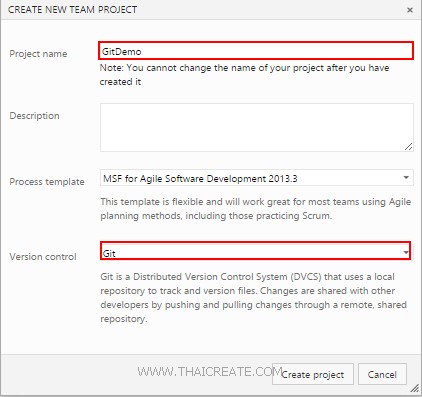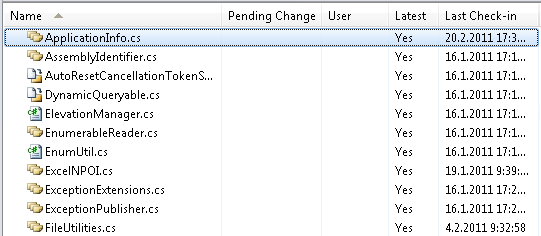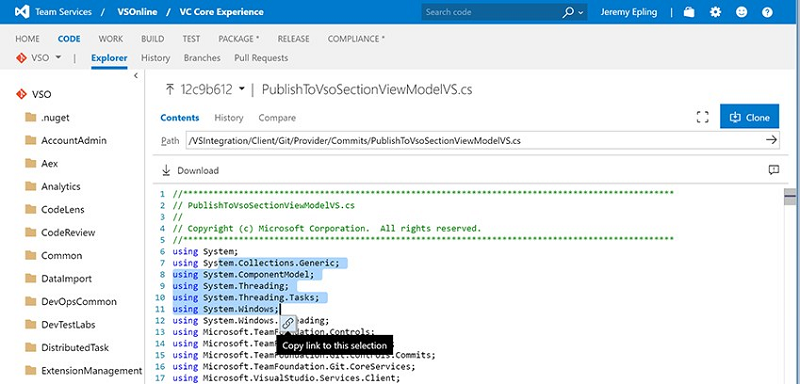

- Microsoft team foundation server source control how to#
- Microsoft team foundation server source control software#
- Microsoft team foundation server source control code#
- Microsoft team foundation server source control professional#
- Microsoft team foundation server source control download#
To do any work with Team Foundation Server, you must first acquire an instance of the root object, TeamFoundationServer. This is how the add-in should behave as well. If the credentials are invalid, Team Explorer displays a dialog asking for a valid user name and password. When using Team Explorer to connect to a box running Team Foundation Server, Team Explorer attempts to connect using your current credentials. As noted, before the add-in can do any work, it needs to connect to a valid Team Foundation Server. In the library you'll create a class called tfsvcUtil that will contain a set of shared members (static in Visual C#®) to perform the heavy lifting with the Team Foundation Server APIs. To get started, you'll want to create a class library, which needs references to the aforementioned assemblies. You'll find browsable copies of the assemblies at %Program Files%\Microsoft Visual Studio 8\Common7\IDE\PrivateAssemblies\.

You'll need to either modify your Windows registry so that the Add References dialog displays the assemblies (see /kb/306149), or manually browse to the assemblies. However, the setup does not register them to show up in the Visual Studio 2005 Add References dialog. The Team Explorer setup application installs the assemblies in the Global Assembly Cache (GAC).

The core set of APIs the add-in uses to interact with Team Foundation Server are contained in three assemblies installed as part of a Team Explorer installation. Microsoft factored the APIs for programming Team System across numerous assemblies. So the add-in needs to perform all of these operations in order to be able to get documents in and out of the Team Foundation Server version control repository.įigure 1** Checking a Word Doc into Team Foundation Server Version Control **(Click the image for a larger view)
Microsoft team foundation server source control code#
The first time you use the source code control features inside Visual Studio 2005 in conjunction with a Team Foundation Server, the Team Explorer tools create a default workspace using the name of your machine. Each workspace, in turn, supports multiple mappings between a local file path, known as a working folder, and a path in the version control repository. Each user can have multiple workspaces on a client machine. A workspace represents the client-side copy of the artifacts that are under version control on the Team Foundation Server, and it serves as an isolated area to perform your work. To perform any version control operations, you need a workspace with a working folder. To do this, you must know the server name, the protocol to use (HTTP or HTTPS), and the port. If you're going to work with Team Foundation Server, the first thing you need to do is connect to a valid server. Since this column is about extending Team System, I won't be covering the details related to hooking the code into the Word infrastructure, but all the code will be provided for you to see.īefore starting, you need to understand the core interaction between Team Foundation Server and my client-side add-in shown in Figure 1-or any other client for that matter.
Microsoft team foundation server source control professional#
In order to build this add-in, you'll need a copy of Visual Studio 2005 Professional (or any of the role-based SKUs including Team Suite), the Visual Studio 2005 Tools for Office Second Edition Beta, and the Visual Studio 2005 Team Explorer. The SDK contains documentation and samples for customizing and extending the entire Visual Studio product line. Before we start, though, head over to /vstudio/extend and get yourself a copy of the Visual Studio 2005 SDK. Along the way, I'll explain how you can build an add-in for Microsoft® Word that allows you to check Word documents in and out of the Team Foundation Server version control repository.
Microsoft team foundation server source control how to#
In the first of what I expect to be many columns, I'll poke around and show you how to extend and enhance Visual Studio Team System on both the client and server.
Microsoft team foundation server source control software#
Around that time, I was at the Microsoft campus in Redmond for a software design review covering an upcoming product that was code-named "Burton." In every review session, I raised my hand and asked the same question: "Will there be extensibility points?" Over the two days, I consistently got an answer that made me smile: "Yes, Brian, you can customize it." Burton, it turns out, became Visual Studio® Team System, and customizing it is what this column is all about. I didn't know it at the time, but in February 2004 this column was conceived.
Microsoft team foundation server source control download#
Code download available at: VSTS 2007_01.exe(199 KB)


 0 kommentar(er)
0 kommentar(er)
